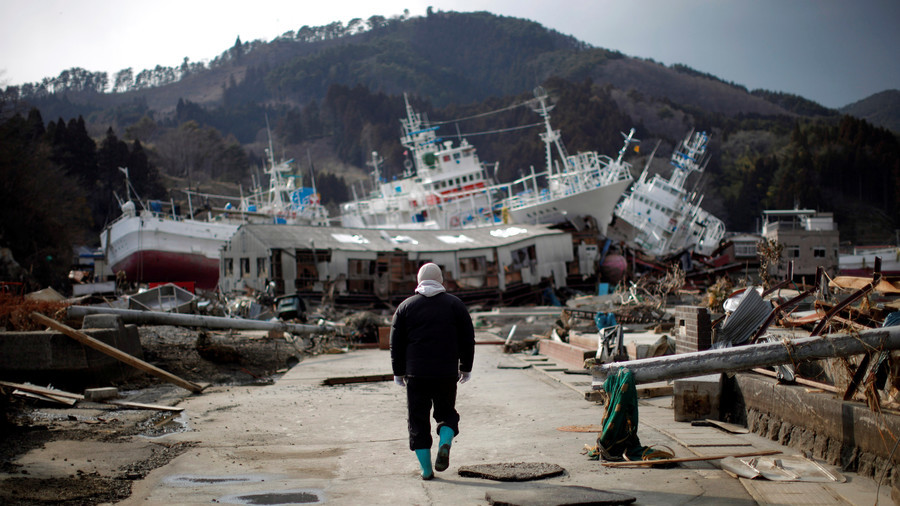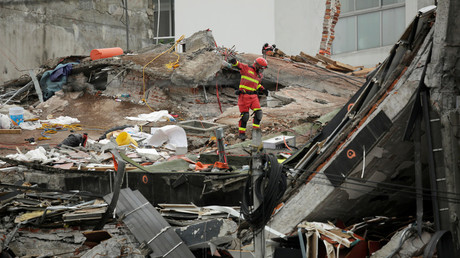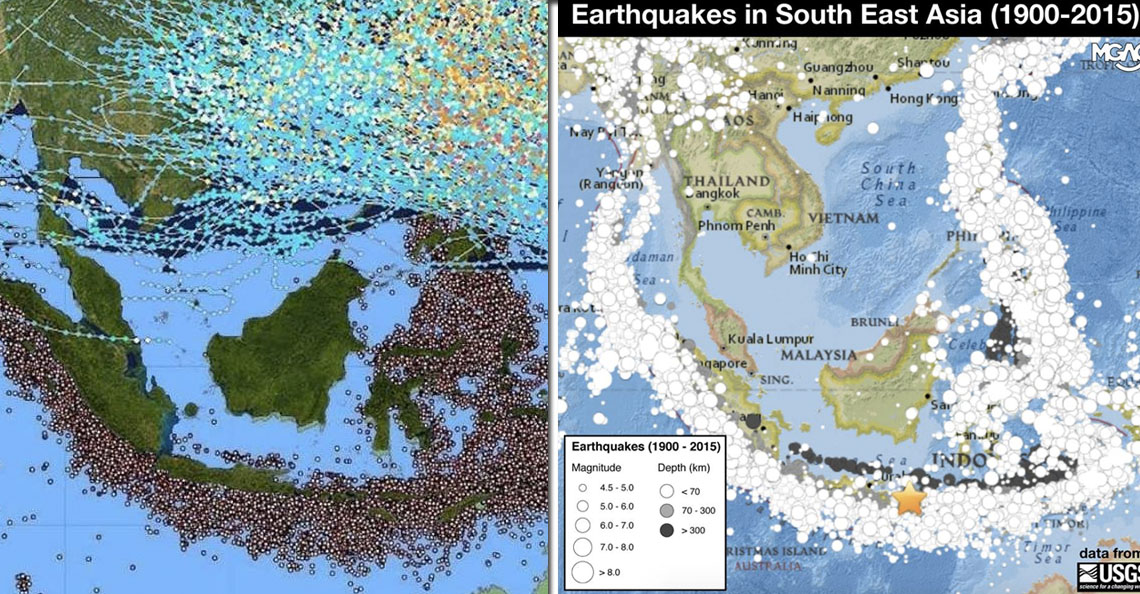https://hk.news.yahoo.com/千島海溝有異動-專家:恐現8-8級以上大地震-011458778.html
千島海溝有異動 專家:恐現8.8級以上大地震

on.cc 東網
11.7k 人追蹤
2019年2月16日 上午9:14

地震預知總合研究振興會研究千島海溝的地震活動。(互聯網)
日本2011年發生的311大地震引發海嘯及福島核災,釀成約1.8萬人死亡。政府專家小組警告,在千島海溝觀測到與311大地震時相似的異動,可能迎來黎克特制8.8級或以上的大地震,恐對東北沿岸地區造成嚴重破壞,政府必須嚴陣以待。
日媒周五(15日)報道,311大地震發生之後,多份報告陸續指出東北地區的地震活動曾出現異常,可能是預示大地震出現的線索。地震預知總合研究振興會的分析部長松浦律子去年8月表示,針對千島海溝下一個出現的地震,研究工作應盡量做得徹底。鑑於千島海溝已出現與上次類近的地震活動,不少科學家均認同將出現不尋常的大地震。
根據地震調查研究推進本部在前年12月公布的報告,指出千島海溝很可能在不久將來出現8.8級以上地震。由於上一次類似的地震是在17世紀前半葉發生,而這類巨大地震的平均間隔為340至380年,因此可推算大地震已迫在眉睫。日本中央防災會議現正審核千島海溝地震的災害評估,北海道政府則將根據最新報告制訂防災措施。
http://www.asahi.com/ajw/articles/AJ201902150001.html
Scientists warn Hokkaido about ‘imminent’ megaquake
By EISUKE SASAKI/ Senior Staff Writer
February 15, 2019 at 07:00 JST
 (The Asahi Shimbun)
(The Asahi Shimbun)
Changes around the Kuril Trench are similar to those observed before the 2011 Great East Japan Earthquake, and a government panel is warning that another tsunami-spawning megaquake could devastate eastern Hokkaido.
Scientists failed to warn against the magnitude-9.0 earthquake and tsunami that struck on March 11, 2011, and killed around 18,000 people on the coast of the northeastern Tohoku region.
With indications that the next “big one” is imminent, they are determined not to make the same mistake.
That sentiment was expressed when Ritsuko Matsuura, who heads the analysis division of the public-interest entity Association for the Development of Earthquake Prediction, addressed a gathering of seismologists in August.
“You should go as far as possible to do thorough research” on the next powerful earthquake striking in the Kuril Trench, she said at a meeting of the government’s Coordinating Committee for Earthquake Prediction. “You cannot say that you have actually identified signs only after the event occurs.”
After the Great East Japan Earthquake struck, a flurry of reports emerged noting changes in seismic activity off the Tohoku region that experts said could have been a “predictor” of the disaster.
The scientists knew that the Tohoku region had been flooded by great tsunami in the distant past. But they could not issue the warning in a timely manner to mitigate the impact of the towering waves that hit the coast eight years ago.
Now, with similar changes in earthquake data from the Kuril Trench running northeast of Hokkaido to the south of the Kamchatka Peninsula in Russia, Matsuura and other scientists are taking no chances.
Many scientists agree that an unusually powerful earthquake could occur in the Kuril Trench in the near future.
The long-term assessment of future earthquakes released in December 2017 by the Headquarters for Earthquake Research Promotion, an expert panel within the science ministry, said there was a “high” likelihood of a magnitude-8.8 or larger quake striking the trench in the near future.
The last known quake of that scale occurred in the first half of the 17th century.
The average interval between such megaquakes is estimated at 340-380 years, which was calculated based on a study of tsunami deposits in eastern Hokkaido and elsewhere.
That means the Kuril Trench is overdue for a huge quake.
A study of earthquakes estimated at magnitude-5.7 or larger since 1965 showed that the occurrence of such temblors had dwindled since around October 2008. But it has been increasing since the latter half of 2015.
A similar quiescence trend was also reported before the Great East Japan Earthquake and other major quakes.
However, a scientific correlation between a decline in seismic activity and a subsequent huge earthquake has not been established. There are also cases in which a major temblor does not follow a “quiet” period.
Experts have also cited crustal movements on the coast of Hokkaido as a sign that the next big earthquake is on the way.
In eastern Hokkaido, the land sank after earthquakes of magnitude-8.0 or larger, including the Tokachioki earthquake of 2003.
But historical traces of the coastline, including sand and other deposits, have been found at elevated areas of the region.
To explain the existence of the coastline on higher ground, scientists hypothesized that unusually large earthquakes caused the land to rise considerably.
Some seismologists say the fast pace of land sinking observed in recent years could be a precursor of an enormous earthquake in the Kuril Trench.
In fact, land in the Tohoku region had been sinking until the Great East Japan Earthquake caused it to rise.
“(Eastern Hokkaido) is in a situation resembling the Tohoku region before the Great East Japan Earthquake,” said Masanobu Shishikura, an expert on tsunami deposits who heads a group of researchers at the government-affiliated National Institute of Advanced Industrial Service and Technology. “We should be fully prepared.”
The expected focal point of the megaquake stretches more than 300 kilometers from the coast of the Tokachi region in eastern Hokkaido to waters northeast of the South Kuril Islands.
A tsunami triggered by the powerful temblor that occurred in the first half of the 17th century in the trench had inundated Hokkaido up to 4 km inland, according to a study.
A similar tsunami could also swamp the Tohoku region, according to some seismologists.
The central government’s Central Disaster Management Council is now reviewing its projected damage assessments for powerful earthquakes along the Kuril Trench and the Japan Trench to the south.
The Hokkaido government is expected to update its anti-disaster measures based on the council’s latest finding.
Quake experts admit they have no clue when an unusually big quake will strike, but they are taking a “better safe than sorry” approach with the expected temblor in the Kuril Trench.
“We should convey to the public our sense of alarm,” Kazuro Hirahara, professor emeritus at Kyoto University, said at a news conference.
Hirahara chairs the Coordinating Committee for Earthquake Prediction, which met twice last year to assess how imminent the temblor is off Hokkaido.
Matsuura called for people living on the coast to immediately flee to higher ground whenever they feel a big jolt.
Tokyo Electric Power Co., which is still battling the tsunami-triggered disaster at its Fukushima No. 1 nuclear plant, plans to install a levee by fiscal 2020 to protect the nuclear complex from another towering tsunami.
TEPCO announced in December that the new levee is designed for a scenario in which a magnitude-9.4 earthquake hits in a focal area stretching along a 1,400-kilometer portion of the Kuril Trench.
The structure will stand at a height of 11 meters above the sea surface and 2.5 meters from the ground of the plant’s core facilities.
The plant sat about 10 meters above sea level before the Great East Japan Earthquake struck.
After the Fukushima disaster unfolded, the company installed a makeshift levee in the southern section of the ground of the plant to prepare for anticipated tsunami caused by aftershocks of the Great East Japan Earthquake.
But no barrier was erected around the nuclear plant itself.
The utility fears that if the plant is hit by another tsunami like the one in 2011, the event would cause leaks of highly radioactive water stored in rows of tanks on the grounds of the plant, resulting in a major delay in decommissioning work.
“We decided to build the barrier based on the long-term assessment” by the science ministry’s Headquarters for Earthquake Research Promotion, TEPCO said.
But the utility did not take action for the same panel’s assessment released in 2002, and the Fukushima No. 1 plant was swamped by the towering tsunami that led to the triple meltdown.
千島海溝有異動 專家:恐現8.8級以上大地震

on.cc 東網
11.7k 人追蹤
2019年2月16日 上午9:14

地震預知總合研究振興會研究千島海溝的地震活動。(互聯網)
日本2011年發生的311大地震引發海嘯及福島核災,釀成約1.8萬人死亡。政府專家小組警告,在千島海溝觀測到與311大地震時相似的異動,可能迎來黎克特制8.8級或以上的大地震,恐對東北沿岸地區造成嚴重破壞,政府必須嚴陣以待。
日媒周五(15日)報道,311大地震發生之後,多份報告陸續指出東北地區的地震活動曾出現異常,可能是預示大地震出現的線索。地震預知總合研究振興會的分析部長松浦律子去年8月表示,針對千島海溝下一個出現的地震,研究工作應盡量做得徹底。鑑於千島海溝已出現與上次類近的地震活動,不少科學家均認同將出現不尋常的大地震。
根據地震調查研究推進本部在前年12月公布的報告,指出千島海溝很可能在不久將來出現8.8級以上地震。由於上一次類似的地震是在17世紀前半葉發生,而這類巨大地震的平均間隔為340至380年,因此可推算大地震已迫在眉睫。日本中央防災會議現正審核千島海溝地震的災害評估,北海道政府則將根據最新報告制訂防災措施。
http://www.asahi.com/ajw/articles/AJ201902150001.html
Scientists warn Hokkaido about ‘imminent’ megaquake
By EISUKE SASAKI/ Senior Staff Writer
February 15, 2019 at 07:00 JST
 (The Asahi Shimbun)
(The Asahi Shimbun)Changes around the Kuril Trench are similar to those observed before the 2011 Great East Japan Earthquake, and a government panel is warning that another tsunami-spawning megaquake could devastate eastern Hokkaido.
Scientists failed to warn against the magnitude-9.0 earthquake and tsunami that struck on March 11, 2011, and killed around 18,000 people on the coast of the northeastern Tohoku region.
With indications that the next “big one” is imminent, they are determined not to make the same mistake.
That sentiment was expressed when Ritsuko Matsuura, who heads the analysis division of the public-interest entity Association for the Development of Earthquake Prediction, addressed a gathering of seismologists in August.
“You should go as far as possible to do thorough research” on the next powerful earthquake striking in the Kuril Trench, she said at a meeting of the government’s Coordinating Committee for Earthquake Prediction. “You cannot say that you have actually identified signs only after the event occurs.”
After the Great East Japan Earthquake struck, a flurry of reports emerged noting changes in seismic activity off the Tohoku region that experts said could have been a “predictor” of the disaster.
The scientists knew that the Tohoku region had been flooded by great tsunami in the distant past. But they could not issue the warning in a timely manner to mitigate the impact of the towering waves that hit the coast eight years ago.
Now, with similar changes in earthquake data from the Kuril Trench running northeast of Hokkaido to the south of the Kamchatka Peninsula in Russia, Matsuura and other scientists are taking no chances.
Many scientists agree that an unusually powerful earthquake could occur in the Kuril Trench in the near future.
The long-term assessment of future earthquakes released in December 2017 by the Headquarters for Earthquake Research Promotion, an expert panel within the science ministry, said there was a “high” likelihood of a magnitude-8.8 or larger quake striking the trench in the near future.
The last known quake of that scale occurred in the first half of the 17th century.
The average interval between such megaquakes is estimated at 340-380 years, which was calculated based on a study of tsunami deposits in eastern Hokkaido and elsewhere.
That means the Kuril Trench is overdue for a huge quake.
A study of earthquakes estimated at magnitude-5.7 or larger since 1965 showed that the occurrence of such temblors had dwindled since around October 2008. But it has been increasing since the latter half of 2015.
A similar quiescence trend was also reported before the Great East Japan Earthquake and other major quakes.
However, a scientific correlation between a decline in seismic activity and a subsequent huge earthquake has not been established. There are also cases in which a major temblor does not follow a “quiet” period.
Experts have also cited crustal movements on the coast of Hokkaido as a sign that the next big earthquake is on the way.
In eastern Hokkaido, the land sank after earthquakes of magnitude-8.0 or larger, including the Tokachioki earthquake of 2003.
But historical traces of the coastline, including sand and other deposits, have been found at elevated areas of the region.
To explain the existence of the coastline on higher ground, scientists hypothesized that unusually large earthquakes caused the land to rise considerably.
Some seismologists say the fast pace of land sinking observed in recent years could be a precursor of an enormous earthquake in the Kuril Trench.
In fact, land in the Tohoku region had been sinking until the Great East Japan Earthquake caused it to rise.
“(Eastern Hokkaido) is in a situation resembling the Tohoku region before the Great East Japan Earthquake,” said Masanobu Shishikura, an expert on tsunami deposits who heads a group of researchers at the government-affiliated National Institute of Advanced Industrial Service and Technology. “We should be fully prepared.”
The expected focal point of the megaquake stretches more than 300 kilometers from the coast of the Tokachi region in eastern Hokkaido to waters northeast of the South Kuril Islands.
A tsunami triggered by the powerful temblor that occurred in the first half of the 17th century in the trench had inundated Hokkaido up to 4 km inland, according to a study.
A similar tsunami could also swamp the Tohoku region, according to some seismologists.
The central government’s Central Disaster Management Council is now reviewing its projected damage assessments for powerful earthquakes along the Kuril Trench and the Japan Trench to the south.
The Hokkaido government is expected to update its anti-disaster measures based on the council’s latest finding.
Quake experts admit they have no clue when an unusually big quake will strike, but they are taking a “better safe than sorry” approach with the expected temblor in the Kuril Trench.
“We should convey to the public our sense of alarm,” Kazuro Hirahara, professor emeritus at Kyoto University, said at a news conference.
Hirahara chairs the Coordinating Committee for Earthquake Prediction, which met twice last year to assess how imminent the temblor is off Hokkaido.
Matsuura called for people living on the coast to immediately flee to higher ground whenever they feel a big jolt.
Tokyo Electric Power Co., which is still battling the tsunami-triggered disaster at its Fukushima No. 1 nuclear plant, plans to install a levee by fiscal 2020 to protect the nuclear complex from another towering tsunami.
TEPCO announced in December that the new levee is designed for a scenario in which a magnitude-9.4 earthquake hits in a focal area stretching along a 1,400-kilometer portion of the Kuril Trench.
The structure will stand at a height of 11 meters above the sea surface and 2.5 meters from the ground of the plant’s core facilities.
The plant sat about 10 meters above sea level before the Great East Japan Earthquake struck.
After the Fukushima disaster unfolded, the company installed a makeshift levee in the southern section of the ground of the plant to prepare for anticipated tsunami caused by aftershocks of the Great East Japan Earthquake.
But no barrier was erected around the nuclear plant itself.
The utility fears that if the plant is hit by another tsunami like the one in 2011, the event would cause leaks of highly radioactive water stored in rows of tanks on the grounds of the plant, resulting in a major delay in decommissioning work.
“We decided to build the barrier based on the long-term assessment” by the science ministry’s Headquarters for Earthquake Research Promotion, TEPCO said.
But the utility did not take action for the same panel’s assessment released in 2002, and the Fukushima No. 1 plant was swamped by the towering tsunami that led to the triple meltdown.


 Huge earthquakes in 2018 will put up to 1bn people at risk – scientists
Huge earthquakes in 2018 will put up to 1bn people at risk – scientists 